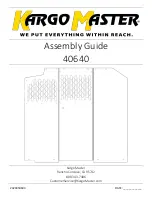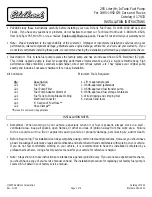
Crossing Obstacles
•
Review the path ahead before
attempting to cross any obstacle. It is
best if the obstacle is reviewed from
outside the vehicle so that there is a
good understanding of terrain condition
both in front of and behind the
obstacle.
•
Approach obstacles slowly and slowly
inch the vehicle over.
•
If a large obstacle such as a rock
cannot be avoided, choose a path that
places the rock directly under the tire
rather than the undercarriage of the
vehicle. This will help prevent damage
to the vehicle.
•
Ditches and washouts should be
crossed at a 45 degree angle, allowing
each wheel to independently cross the
obstacle.
Hill Climbing
WARNING:
Extreme care should be
used when steering the vehicle in reverse
down a slope so as not to cause the vehicle
to swerve out of control.
•
Always attempt to climb a steep hill
along the fall line of the slope and not
diagonally.
•
If the vehicle is unable to make it up
the hill, DO NOT attempt to turn back
down the slope. Place the vehicle in
low range and slowly back down in
reverse.
•
When descending a steep slope, select
low gear and engage hill descent
control. Use the throttle and brake
pedals to control your descent speed
as described earlier in this section using
hill descent control. Note that hill
descent control is functional in reverse
and should be used in this situation.
Water Wading
Your vehicle is designed to operate in water
depths up to 850 mm. However, as the
water depth increases, vehicle speed must
be reduced to avoid potential vehicle
damage.
•
Always determine the depth before
attempting a water crossing.
•
Proceed slowly and avoid splashing
water any more than is necessary.
•
Be aware that obstacles and debris
may be beneath the water’s surface.
•
Keep the doors fully closed during the
water crossing.
•
Upon completion of the water crossing,
slowly drive a short distance and check
the brakes for full effectiveness.
Refer to the chart below for the maximum
allowable speeds when driving through
water.
Note:
Failure to follow the recommended
speeds may result in vehicle damage.
Maximum Allow-
able Vehicle Speed
Water Depth
65 km/h
150 mm
50 km/h
200 mm
30 km/h
250 mm
12 km/h
300 mm
7 km/h
450 mm -
850 mm
Less than 10 km/h
Reverse – up to
760 mm
25
Ranger Raptor (TKD) Raptor, Vehicles Built From: 21-05-2018, JB3B 19A285 CKA enPHI, Edition date: 201804, First-Printing
Driving Hints
Summary of Contents for Ranger Raptor 2018
Page 3: ......
















































